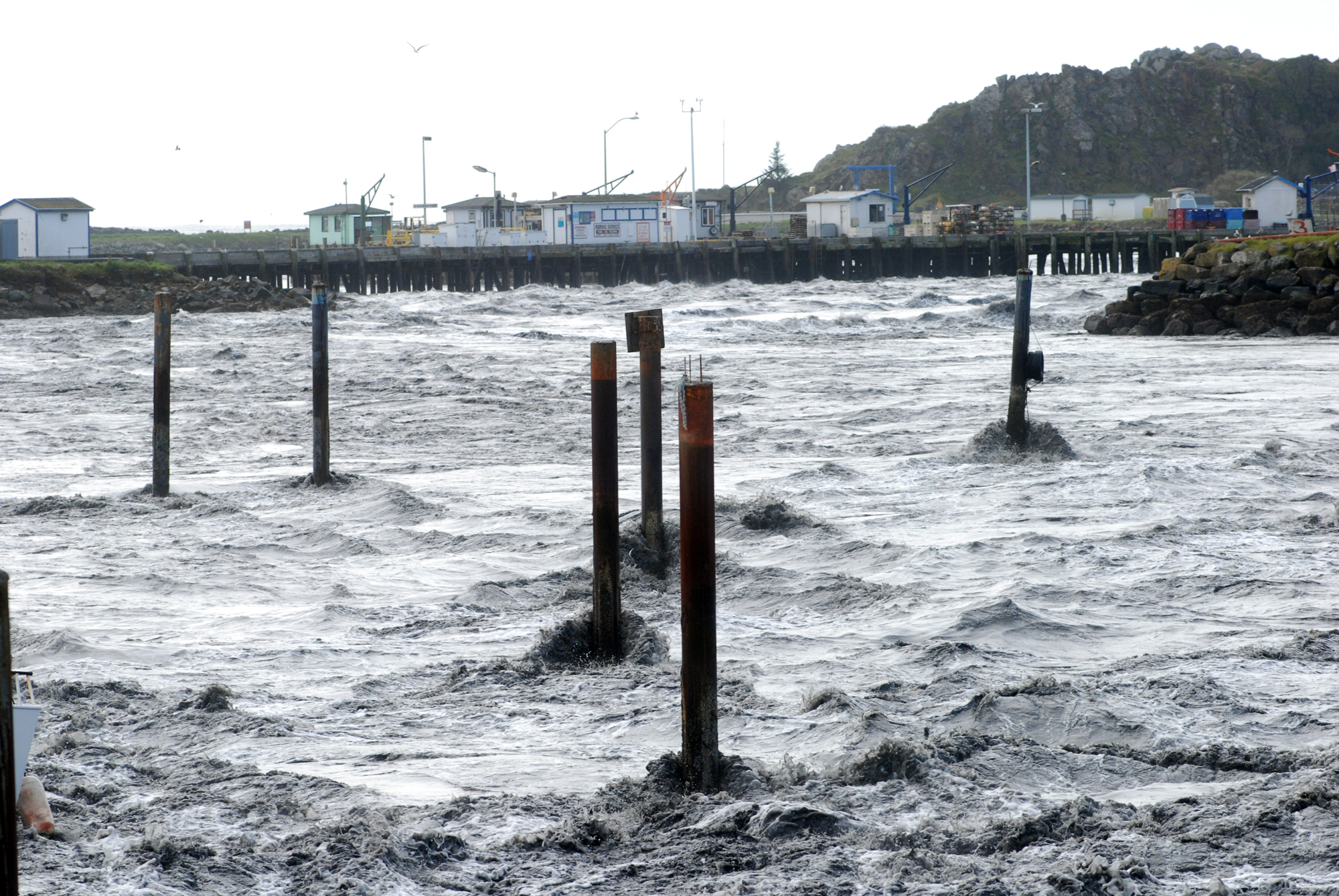 Rough waters are shown in the boat basin at Crescent City, Calif on Friday, March 11, 2011. A ferocious tsunami unleashed by Japan's biggest recorded earthquake slammed into its eastern coast Friday, killing hundreds of people as it carried away ships, cars and homes, and triggered widespread fires that burned out of control. Hours later, the waves washed ashore on Hawaii and the U.S. West coast, where evacuations were ordered from California to Washington but little damage was reported. The entire Pacific had been put on alert _ including coastal areas of South America, Canada and Alaska _ but waves were not as bad as expected. (AP Photo/Jeff Barnard)
Rough waters are shown in the boat basin at Crescent City, Calif on Friday, March 11, 2011. A ferocious tsunami unleashed by Japan's biggest recorded earthquake slammed into its eastern coast Friday, killing hundreds of people as it carried away ships, cars and homes, and triggered widespread fires that burned out of control. Hours later, the waves washed ashore on Hawaii and the U.S. West coast, where evacuations were ordered from California to Washington but little damage was reported. The entire Pacific had been put on alert _ including coastal areas of South America, Canada and Alaska _ but waves were not as bad as expected. (AP Photo/Jeff Barnard)JEFF BARNARD,Associated Press
CRESCENT CITY, Calif. (AP) - The Coast Guard searched for a man Friday who was swept out to sea by powerful waves generated by the tsunami in Northern California while taking photos near the mouth of the Klamath River in Del Norte County.
Two friends with him were able to get back to shore, but the man remained missing.
Coast Guard officials said they have dispatched helicopters in search of him.
The tsunami triggered by the massive earthquake in Japan rushed onto California's coast Friday morning, causing powerful surges that destroyed boat docks as beach-area residents throughout the state evacuated to higher ground.
The tide began rising shortly after 7:30 a.m. along beaches in Crescent City, near the Oregon border, where the tsunami had been expected to hit the hardest in California. Officials predicted that waves could reach as high as 7 feet there.
Local officials activated tsunami warning sirens in Del Norte and Humboldt counties at dawn, and sheriff's deputies went door to door in Crescent City at dawn to urge residents in low-lying areas to seek higher ground.
By midmorning, water rushing into the harbor had destroyed about 35 boats and ripped chunks off the wooden docks, as marina workers and fishermen scrambled to secure property in between surges. When the water returned, someone would yell "Here comes another one!" to clear the area.
"The last surge filled the entire harbor up to the brim and the next one is expected to spill into the parking lot," said Bill Steven, a commander with the Del Norte County Sheriff's Office. "The damage from this is probably going to go into the millions, easily."
Ted Scott, a retired mill worker who lived in Crescent City when a 1964 tsunami killed 17 people on the West Coast, including 11 in his town, watched the water pour into the harbor.
"This is just devastating. I never thought I'd see this again," Scott said. "I watched the docks bust apart. It buckled like a graham cracker."
The waves, however, had not made it over a 20-foot break wall protecting the rest of the city, and no serious injuries or home damage was immediately reported.
The tsunami also caused significant boat damage on California's central coast in Santa Cruz, where loose fishing boats crashed into one another and chunks of wooden docks also broke off. The water rushed out as quickly as it poured in, leaving the boats tipped over in mud.
"I'm worried about the damage, not just to the boat but to the whole harbor infrastructure," said Dave Emberson, an engineer and local harbor official in Santa Cruz.
The swells also knocked loose some boats and damaged the dock in nearby San Luis Obispo County's Morro Bay.
The tsunami warning prompted voluntary evacuation orders in low-lying coastal areas throughout the state. Local officials also closed schools and coastal roads as a precaution.
That didn't stop surfers from ignoring evacuation warnings and taking advantage of the Santa Cruz waves ahead of the tsunami. In Los Angeles, Coast Guard crews working to secure the Venice Pier area also had to order a handful of surfers out of the water.
Darren Lee, a photographer who surfs daily in Santa Cruz, carried his board down the narrow staircase at Cypress Point about 10 minutes before the tsunami was due and paddled out to his regular spot.
Immediately he could tell something was different.
"It was a low tide but it felt like a medium tide. It was real bouncy. There was a lot of current," Lee said.
After surfing for about a half-hour, he decided to come back in. Tsunamis, it seems, aren't conducive to good surf.
"It was really inconsistent," he said, "and I was like, OK, it's like this because there's a tsunami. Now I've been there."
Associated Press writers Martha Mendoza in Santa Cruz, Daisy Nguyen in Los Angeles and Garance Burke in San Francisco contributed to this report.
